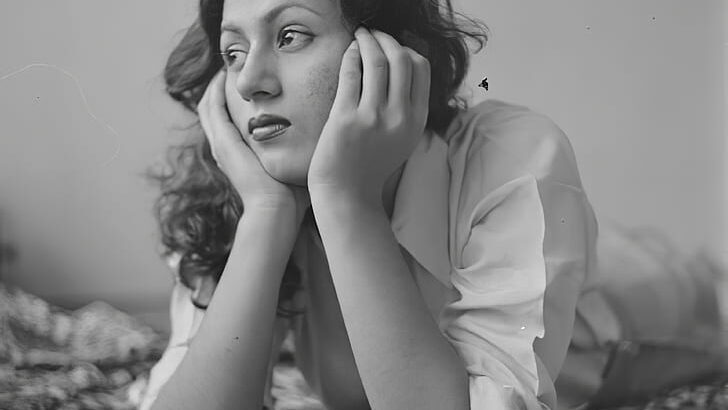The Mesmerizing Madhubala
The Enigmatic Spell of Madhubala: An Iconic Figure in Indian Cinema Madhubala, a name that resonates with grace, talent, and timeless beauty, captivated audiences long before reaching the pinnacle of her career. Her fame was so profound that she even had a film named after her while still in the early stages of her journey, becoming a subject of parody during her active years. Furthermore, she holds the distinction of being the only Indian film actress to have a song dedicated to her played at the prestigious Olympics. This was the enchanting allure of Madhubala, whose celestial features, bewitching smile, and radiant beauty, combined with her restrained yet undeniable talent, made her an integral part of some of Hindi cinema’s most iconic films. Although she is etched in the hearts and minds of film enthusiasts as the winsome and mesmerizing Anarkali in “Mughal-e-Azam” (1960), the captivating nightclub singer in “Howrah Bridge,” and for her exuberant charm in romantic comedies like “Chalti Ka Naam Gaadi” (1958), “Jhumroo” (1961), and “Half Ticket” (1962), Madhubala’s influence extended across various film genres. She left an indelible mark beyond the realm of romantic dramas, delving into ghostly tales, gothic narratives, comic crime capers, and film noir, all within the relatively short span of her career. Born in Delhi in 1933 into an orthodox Pashtun family as Mumtaz Jahan Begum, Madhubala’s childhood was marked by restrictions imposed by her traditional upbringing. However, at the age of seven, circumstances forced her into contributing to the family’s livelihood when her father lost his job with Imperial Tobacco. She began her artistic journey by singing on the All India Radio for the renowned music virtuoso Khwaja Khurshid Anwar. In 1941, the family relocated to Bombay (now Mumbai) to better capitalize on her talents and pave the way for her entry into films. Unfortunately, Madhubala’s career and personal life were tightly controlled by her father, denying her the autonomy she desired. This familial dominance would later shatter a budding romance, as events unfolded in the years to come. Her cinematic debut came with an uncredited role in “Bahar” (1942), a progressive film for its time, depicting a woman striving to make a living afterbeing abandoned by her husband. As a child artist, she went on to appear in several more films before garnering attention with the costume drama “Neel Kamal” (1947), which also marked the first lead role for Raj Kapoor. It was during this period that Devika Rani, known for her influential role in naming Ashok Kumar and Dilip Kumar, suggested that she adopt the screen name Madhubala. Madhubala starred in another seven or eight films, most of which are unfortunately lost to time, in 1947 and 1948. However, her breakthrough came with the hauntingly captivating film “Mahal” (1949), where her ethereal presence was accompanied by the timeless song “Aayega Aanewala,” introducing the voice of Lata Mangeshkar to Indian cinema. Another significant success that year was “Dulari,” in which she portrayed the eponymous role of a wealthy heiress kidnapped in her childhood and raised by gypsies. In 1950, she shared the screen with all the leading heroes of that era, appearing opposite Ashok Kumar in “Nishana,” Dev Anand in “Nirala,” Motilal in “Hanste Aansoo” (the first film to bear an ‘A’ certificate), Ajit in “Beqasoor,” Dev Anand again in “Madhubala” (named after her), and Rehman in “Pardes.” Her first collaboration with Dilip Kumar came in “Tarana” (1951), a film known for the soulful duet “Seene mein sulagte hai arman,” which sparked the kindling of their romance. This relationship endured until the controversial period surrounding “Naya Daur,” where she was sued for walking out of the film, and he testified against her. Nevertheless, they subsequently worked together in “Sangdil” (1952) and “Amar” (1954) before starring in K. Asif’s magnum opus, “Mughal-e-Azam.” However, Madhubala refused to be typecast and showcased her versatility by working in offbeat romances like “Nazneen” (1951), embarking on treasure hunt adventures in “Khazana” (1951) – where she became possibly the first Indian heroine to sport trousers onscreen, making it a regular habit both on and off the screen – exploring Arabian Nights- inspired narratives in “Saqi” (1952), and captivating audiences with urban romantic dramas like “Rail Ka Dibba” (1953). In the latter, she left her co-star, Shammi Kapoor, awe-struck, as he confessed even after six decades that he couldn’t erase her from his mind. He fondly reminisced, “I can swear that I have never seen a more beautiful woman. Add to that her sharp intellect, maturity, poise, and sensitivity… When I think of her even now, after six decades, my heart misses a beat. My God, what beauty, what presence.” Madhubala also showcased her comedic prowess in “Mr. and Mrs. 55” (1955) opposite Guru Dutt and embraced the noirish adventure genre in “Gateway of India” (1957), featuring an ensemble cast. Notably, the latter film was the first to depict a heroine chasing after the hero to propose to him, defying traditional gender roles. One of Madhubala’s most outstanding performances came in the Muslim social film “Barsaat Ki Raat” (1960), where she delivered a masterclass in effortless emoting, portraying vulnerability, longing, and resilience, among other complex emotions. While her performances in approximately 70 films garnered her a legion of fans in India and beyond, Madhubala’s popularity extended to Southeast Asia, East Africa, and even Greece. In fact, popular Greek singer Stelios Kazantzidis paid tribute to her by producing the song “Mandoubala” after her passing, and it was played at the closing ceremony of the 2004 Athens Olympics. Madhubala often drew comparisons to her near- contemporary Marilyn Monroe. Both remarkable women left the world far too soon, at the age of 36. However, Madhubala didn’t view herself as a sex symbol like her American counterpart, and she was not entirely pleased with the comparison. Unfortunately, Madhubala’s personal life was fraught with challenges. She was born with a congenital heart condition that left her breathless and weak. At the time, there were no surgical remedies available, and her health steadily deteriorated, rendering her incapacitated during the final years of her life before eventually succumbing to her condition. On the other hand, following the tumultuous end of her relationship with Dilip Kumar – a story he candidly shared in his autobiography, primarily blaming her father for turning it into a business arrangement – Madhubala reportedly attracted the attention of numerous top actors, including those who were married. However, she declined all proposals. Eventually, she married Kishore Kumar in 1960, but their marriage was fraught with difficulties due to her deteriorating health, and their union was far from a joyous one. Tragically, Madhubala passed away in 1969, leaving behind an indelible legacy in Indian cinema. Madhubala’s tale is one of extraordinary talent, resilience, and untimely tragedy. She remains an enigma, forever etched in the annals of Indian cinema as a beacon of beauty, elegance, and artistry. Her impact transcends borders and generations, her name synonymous with an era of cinematic brilliance that continues to inspire filmmakers and captivate audiences to this day.
Search
Categories
Tags











